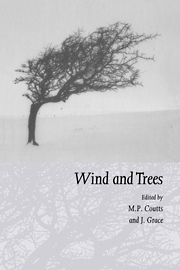Book contents
- Frontmatter
- Contents
- Preface
- List of contributors
- Part I Airflow over topography and in forests
- 1 Turbulent airflow in forests on flat and hilly terrain
- 2 The interactions of wind and tree movement in forest canopies
- 3 Edge effects on diffusivity in the roughness layer over a forest
- 4 A wind tunnel study of turbulent airflow in forest clearcuts
- 5 Testing of a linear airflow model for flow over complex terrain and subject to stable, structured stratification
- 6 Predicting windspeeds for forest areas in complex terrain
- Part II Mechanics of trees under wind loading
- Part III Tree physiological responses
- Part IV Impacts of wind on forests and ecology
- Part V Risk assessment and management response
- Index
1 - Turbulent airflow in forests on flat and hilly terrain
Published online by Cambridge University Press: 27 October 2009
- Frontmatter
- Contents
- Preface
- List of contributors
- Part I Airflow over topography and in forests
- 1 Turbulent airflow in forests on flat and hilly terrain
- 2 The interactions of wind and tree movement in forest canopies
- 3 Edge effects on diffusivity in the roughness layer over a forest
- 4 A wind tunnel study of turbulent airflow in forest clearcuts
- 5 Testing of a linear airflow model for flow over complex terrain and subject to stable, structured stratification
- 6 Predicting windspeeds for forest areas in complex terrain
- Part II Mechanics of trees under wind loading
- Part III Tree physiological responses
- Part IV Impacts of wind on forests and ecology
- Part V Risk assessment and management response
- Index
Summary
Abstract
The turbulent velocity field in and above homogeneous forest canopies on flat ground has several universal features. These include a mean velocity profile with a point of inflexion; vertical inhomogeneity in second moments; positive u and negative w skewnesses; and integral length scales of order h, the canopy height. These features scale with u* and h across a wide range of wind tunnel models and real canopies. Turbulence spectra also share common features such as vertical invariance of the position of the spectral peak and departures from classical inertial subrange behaviour. Many of these characteristics are more similar to what is observed in a plane mixing layer than in a boundary layer. The eddy structure of a plane mixing layer owes its origin to the instability of its inflexion point velocity profile, one of the features it shares with canopy flows. Linear perturbation models of this instability yield results that fit well with the eddy structure observed in canopies, strongly suggesting that it is instability of the canopy mean velocity profile, a profile set by the momentum absorption capacity of the canopy as a whole, that controls the universal turbulent structure of plant canopy flow. Turbulence produced directly by eddies shed from plant parts plays a minor role. Turbulent airflow over isolated hills also displays some characteristic features, including a large relative velocity speed-up at low levels above the hill crest. It can be demonstrated that this is caused by the pressure field set up by the whole of the flow field around the hill. In this sense it can be regarded as ‘imposed’ on any canopy growing on the hill.
- Type
- Chapter
- Information
- Wind and Trees , pp. 3 - 40Publisher: Cambridge University PressPrint publication year: 1995
- 59
- Cited by



